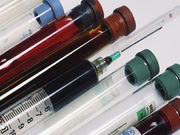Ten days of treatment linked to increase in peak thrombin, velocity index, PAI-1, and vWF
TUESDAY, Jan. 26, 2016 (HealthDay News) — For healthy subjects, 10 days of prednisolone therapy induces a procoagulant state, according to a study published online Jan. 21 in the Journal of Thrombosis and Haemostasis.
Christof J. Majoor, M.D., from the Academic Medical Center in Amsterdam, and colleagues examined whether a 10-day prednisolone burst therapy activates hemostasis. Healthy individuals received either 0.5 mg/kg/day oral prednisolone (15 subjects) or placebo (16 subjects). Venous blood was collected at baseline, day 1, and day 10.
The researchers found that the placebo group had higher peak thrombin and velocity index at baseline. Peak thrombin (15.8 versus −0.1), velocity index (41.2 versus −2.3), plasminogen-activator inhibitor type-1 (18.0 versus 0.5), and von Willebrand factor (4.0 versus 0.0) were increased in the oral prednisolone versus the placebo group after 10 days of treatment. There were no changes seen for thrombin-antithrombin complexes, endogenous thrombin potential, plasmin-alpha2-antiplasmin complexes, or D-dimer.
“Oral prednisolone induces a procoagulant state in healthy subjects, suggesting that corticosteroid treatment may increase thromboembolic risk in patients with inflammatory diseases,” the authors write.
Copyright © 2016 HealthDay. All rights reserved.








